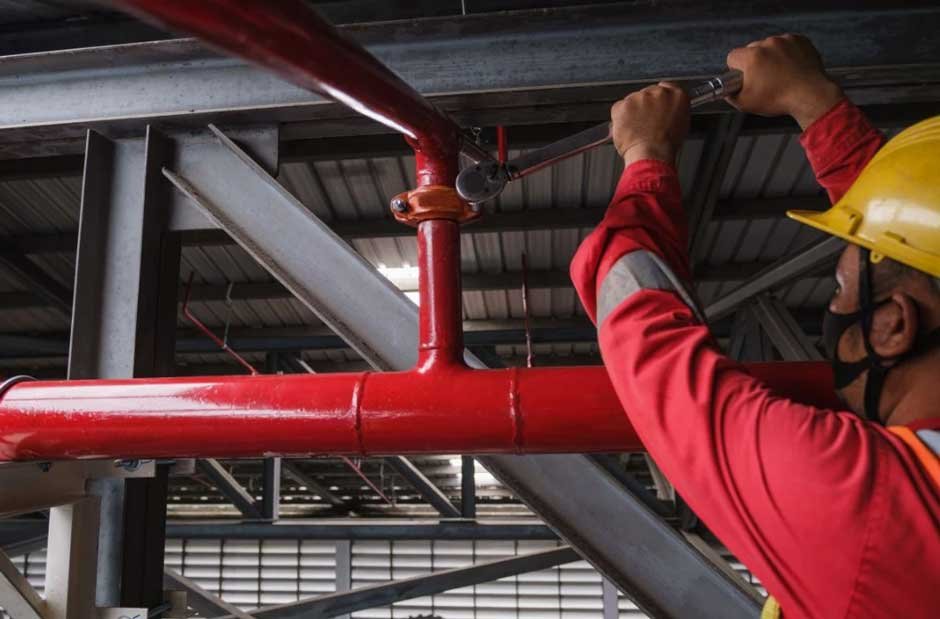Designed to detect, control, and extinguish fires, fire fighting systems have become a necessity for every building. They not only stop the spread of fire but also help to protect lives and property. That’s why, having an effective fire protection system can make all the difference between a minor incident and a major disaster.
What is a Fire Fighting System?
A fire fighting system is a network of equipment and devices that work together to ensure the safety of residents and property when a fire breaks out. These systems, commonly installed in residential, commercial, and industrial buildings, work by providing early fire detection signs. They alert the occupants and suppress fire before it can spread.
Components of an Effective Fire Fighting System
A fire protection system design is divided into 3 main parts:
1. Fire Detection System
These systems act as the first line of defense against fire. They detect the early most signs of fire and trigger alarms to alert residents and also activate the fire suppression systems installed in the building. Fire detection systems include:
Smoke Detectors: As the name suggests, these devices detect smoke – the first and the earliest signs of fire. When smoke is detected, the system triggers fire alarms to warn building occupants of potential fire breakouts.
Heat Detectors: Like smoke detectors respond to rising smoke, heat detectors respond to a rise in temperature. These detectors are especially useful in environments where smoke detectors might trigger false alarms, such as in kitchens or garages. By sensing a rapid increase in temperature, heat detectors help in identifying fires that might otherwise go unnoticed.
Fire Alarms: Fire alarms are the audible component of a fire detection system. They are designed to alert building residents in the event of fire. Fire alarms produce loud sounds and flashing lights to alert occupants and signal them to evacuate the premises promptly.
2. Fire Suppression Systems
As the name suggests, fire suppression systems work to suppress or control the outbreak of fire. Once activated, they release water, foam, gas, or other extinguishing agents, depending on their type and the environment. These include:
Fire Sprinkler Systems: These are small devices that are strategically installed throughout a building to detect and control fires in their early stages. Fire sprinkler systems get automatically activated when a fire is detected, releasing water to control or extinguish the flames. Modern fire sprinkler system designs are created using advanced CAD tools like AutoSPRINK, to ensure precise planning and optimal placement of sprinkler heads and piping throughout the building. CAD design and drafting technology enables fire protection engineers to simulate various fire scenarios and create efficient fire sprinkler system designs that respond to fire effectively and ensure complete coverage even in complex or irregularly shaped spaces.
Fire Extinguishers: Portable and easy to use, fire extinguishers are essential for tackling small fires before they spread. They come in different types, such as water, foam, CO2, and dry powder, each suited for specific kinds of fires (e.g., electrical, flammable liquids). Proper placement and regular maintenance of fire extinguishers are crucial for ensuring they are effective when needed.
Specialized Fire Suppression Systems: In environments where water isn’t ideal (like server rooms or archives), specialized suppression systems that use gas, foam, or chemicals are deployed. These systems quickly suppress fires without causing additional damage to sensitive equipment or valuable documents. They are designed to disperse their fire-suppressing agents evenly, ensuring that the fire is controlled effectively.
3. Fire Protection Systems
Fire protection systems focus on preventing the spread of fire and ensuring the safety of building occupants. These systems include:
Fire-Resistant Building Materials: Materials like fire-rated doors, fire retardant blinds, and fire-resistant glass help to contain the spread of fire. Using them during the construction and designing of a building is a proactive measure toward fire protection.
Emergency Lighting: In the event of fire, power failures are common, which makes evacuation difficult and dangerous. Emergency lighting systems automatically activate during a power outage. They illuminate exit routes, stairwells, and corridors, guiding occupants safely out of the building.
Exit Signs: Designed to glow in the dark, exit signs indicate the nearest safe exit during an emergency. These signs help occupants find their way out quickly, even in low visibility conditions caused by smoke. Many exit signs are powered by emergency lighting systems too.
Why Every Building Needs a Well-Designed Fire-Fighting System?
Fire protection systems are critical for safeguarding lives, property, and business. Here are several reasons why every building needs such a system:
- Legal Compliance: Most countries have strict fire safety regulations requiring buildings to have fire fighting systems. Fire safety compliance is not only a legal obligation but also essential for the safety of occupants.
- Life Safety: The primary purpose of a fire protection system is to save lives. By detecting fires early and suppressing them before they spread, these systems give residents time to safely evacuate the building.
- Property Protection: Fires cause extensive damage to the property. Fire protection systems help contain and extinguish fires quickly. This minimizes damage and reduces the cost of repairs and restoration.
- Business Continuity: For commercial buildings, a fire can result in significant downtime and loss of business. An effective fire strategy ensure that operations can resume as quickly as possible after an incident.
- Insurance Requirements: Many insurance companies require buildings to have fire fighting systems in place as a condition for coverage. Proper systems can also lead to lower insurance premiums.
While fire fighting systems are an important component of every building, the ideal fire protection system design depends on your building type, occupancy and escape routes. That’s why it is important to partner with reputed fire protection system design experts who can help you create the right fire safety strategy for your building.
Choose the best fire protection system design experts and create a fool-proof emergency plan for your building!

